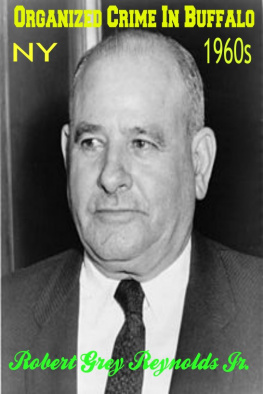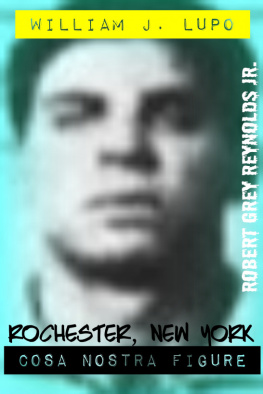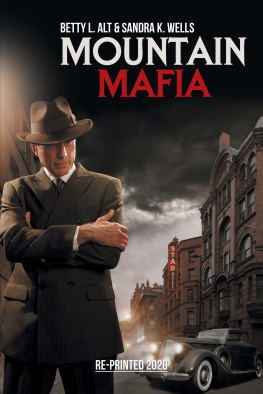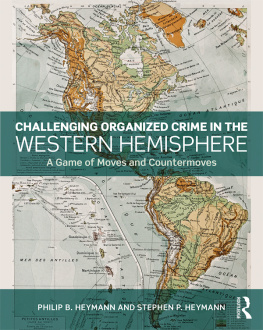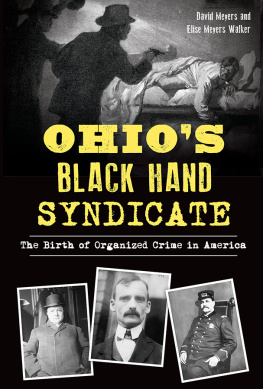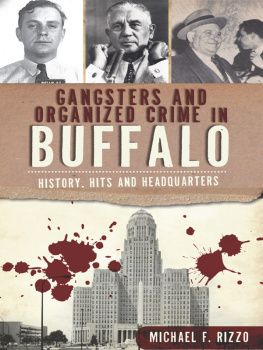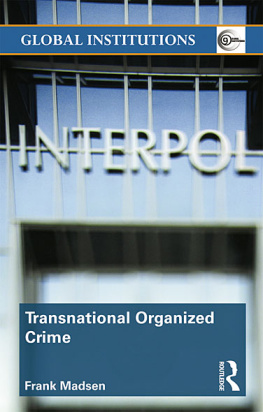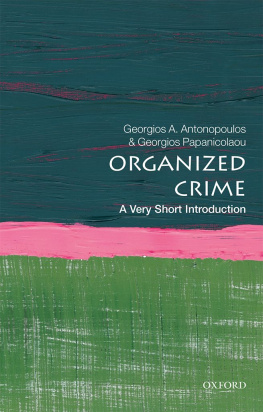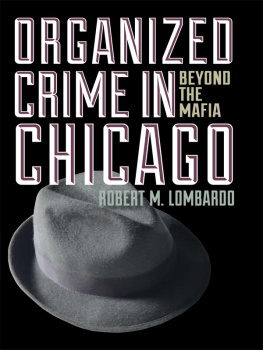Organized Crime in Buffalo,New York (1960s)
Published by Robert GreyReynolds Jr. at Smashwords
Copyright 2016 by RobertGrey Reynolds Jr.
On October 16, 1963 Buffalopolice described Stefano Magaddino as theirrefutable lord paramount and titular head of syndicated organizedcrime in the Buffalo-Niagara Falls and Toronto areas. The description was made by Lt. Michael A. Amicoof the Buffalo Police Department's Intelligence Bureau. Amicooffered his description before a Senate Investigations Committee.Buffalo Police Commissioner William Schneider also testified at thesubcommittee's hearing on organized crime.
The subcommittee displayed achart titled, The Buffalo New YorkOrganization. The names and photos oftwenty-one men, identified as underworld leaders by Buffalo Police,appeared on the chart. Magaddino and John C. Montana of Buffalowere at the top.
The names of Magaddino associatesincluded James LaDuca, Dominic D'Agostino, Samuel Rangatore,Dominic Mantele and Benjamin Nicoletti. All were from Niagara Fallsand Lewiston.
A separate chart, entitledBuffalo Magaddino Empire of Organized Crime, named FredRandaccio as Maggadino's heirapparent. Magaddino was described as bossof the entire western New York area, together with the Ohio Valleyregion.
Section leaders of theMagaddino empire included Salvatore Brocato, Joseph Fino, SalvatoreBonito, Daniel Sansanese, Paul Briandi, Anthony Perna,Salvatore Sam Rizzo, Pascal Politano, Sam Lagattuta, Salvatore Miano andMichael Tascarella.
John Camillieri, PascalNatarelli, Roy Carlisi and Steven Cammarozzo were listed as four ofMaggadino's lieutenants. Officer Amico said Magaddino's immediatelieutenants were D'Agostino, Rangatore, Mantele andNicoletti.
D'Agostino was involvedin narcotics activities while Nicoletti handled gamblingaffairs. Rangatore. a vending machine operator, also served as abodyguard and dealt with enforcement type activities. Mantele, atrusted lieutenant of Don Stefano, coordinated several types ofactivity for the crime syndicate.
Buffalo lieutenant JohnCamilleri, 52, handled union affairs for Magaddino. He also workedwith the Niagara Falls locals for construction on the powerproject. Camilleri maintained close ties with Hod Carriers LocalNo. 210. His criminal record dated back to 1930.
Officer Amico had this tosay about Stefano Magaddino. Don Stefano isin absolute control of all the illegal operations in the area aspertains to organized criminal activities. No crime by members ofthe organization is permitted without his permission andguidance.
On August 16, 1921 StefanoMagaddino was a fugitive from justice relative to a homicide atAvon, New Jersey. He was turned over to the Avon Police Department.Informed police authorities believe Stefano Magaddino was among thevisitors to the notorious Appalachin meeting, November 14, 1957 .
Magaddino's clothes werefound on the premises where the Appalachin meeting was held. It wasunlikely that such a meeting would have been held without Magaddinobeing present. He had extensive criminal interests and assumed alarge role in the syndicate's decisions. Don Stefano also had agreat influence on politics in the Niagara Falls area prior to theAppalachin meeting. Before the Appalachin convention Montana wasrevealed as Magaddino's second in command.
Between Appalachin and 1963Don Stefano ceded complete control of his legitimate businesses includingMagaddino Memorial Chapel and the Power City Distributing Companyof Niagara Falls.
Antonio Magaddino, Stefano Magaddinosbrother, was vice-president of Magaddino Memorial Chapel. He alsorepresented Stefano at various business meetings carried out by theunderworld. Prior to Appalachin Antonio dealt regularly withBuffalo gangland associates. His was an ubiquitous presence atBuffalo nightclubs where thugs regularly congregated. Officer Amicostated that before the Appalachin meeting Antonio Magaddino had nocriminal record in the United States. However he had been arrestedon numerous occasions in Italy for different crimes.
Pertaining to JamesLaDuca's record and underworld involvement, Amico mentioned thatLaDuca had married one of Stefano Magaddino's daughters. Prior tothe Appalachin meeting LaDuca had no criminal record aside from hisassociations with members of organized crime. At one time LaDucahad driven a taxi for the Van Dyke Taxi Company, owned by JohnMontana. LaDuca also served as secretary-treasurer of the MagaddinoMemorial Chapel.
Amico's testimony aboutLaDuca revealed that he had a concealed interest in the CharlesDistributing Company. The business formerly held a beer license inNiagara Falls, through his wife Angelina Magaddino. In 1962 LaDucaand Issie Morganstern of Rochester went on trial for violation ofthe Taft-Hartley Act, a charge which LaDuca was acquitted of. A1961 conspiracy to obstruct justice ujghdkyhggcharge was againstLaDuca was also dismissed in New York District Court, New YorkCity.
One high-ranking Mafia enforcer andfive other men were convicted in Federal Court in Buffalo ofplotting two major robberies. One of these was a $500,000 jewelryheist in Beverly Hills, California.
One of the defendants, FredericoRandaccio, also known as Fred Lupo, was listed as the heir apparentto Steffano Magaddino during 1963 United States Senatetestimony.
Magaddino headed a branch of La CosaNostra in western New York. Randaccio and four cohorts wereconvicted of conspiracy to commit two February 1965 jewelryrobberies at the Beverly Hilton Hotel in Los Angeles. Neitherjewelry heist was actually carried out.
A nine man, three woman jury returnedguilty verdicts on both counts against Randaccio, 60, and hisco-defendants, Pasquale Natarelli, 56, Steven Cino, 30 and CharlesCaci, 30. All defendants were from Buffalo. Louis Sorgi, 46, livedin Sherman Oaks, California but he was formerly from Buffalo. BothRandaccio and Natarelli were given 20-year prison terms.
Senate testimony describedNatarelli as Randaccio's first lieutenant while authorities alsolinked Cino to the underworld. All five defendants facedmaximum sentences of up to 25 years in prison and $30,000 in fines. The verdicts by Federal Judge John O. Hendersonfollowing twelve hours of jury deliberation. This concluded a threeweek trial. After the verdicts were read the defendants were takeninto custody pending a bail hearing.
Prison inmate PascalCalabrese testified that he learned of the plans for the jewelrobbery heists during conversations with the defendants in Buffalo,and on the West Coast. Calabrese, serving time for a $299,000robbery at Buffalo City Hall in 1964, learned that the armored cartheft would be good for about$100,000.
The prosecution chargedthat the five men had conspired to rob an armored car messenger.They intended to steal about $500,000 worth of jewelry from a Mrs.Walker McCune of Rancho Santa Fe, California and Phoenix, Arizona.McCune was a regular guest in the penthouse suite at the BeverlyHilton Hotel.
Asst. U.S. Attorney Andrew F. Phelan,who prosecuted the case, named Randaccio as the mastermind of theconspircay. Natarelli was singled out as Randaccio's right handman. Sorgi, the chief security officer at the Beverly Hilton Hotel,was named as the man on the inside. According to prosecutor PhelanSorgi befriended Mrs. McCune and also helped plan theheists.
At the end of 1968 Stefano Magaddinoawaited trial on charges of involvement in an internationalgambling ring. 77 years old, it was the first time Magaddino hadbeen charged with a crime since 1921. Formerly charged with being afugitive from justice the earlier offense was dropped from therecord.
Magaddino's son was one of nine menindicted on charges of participation in an international gamblingring. The Internal Revenue Service had placed liens on Magaddinoand others in the case. The money involved amounted to severalhundred thousand dollars. There had been fifteen convictions by theend of December 1968. These included five individuals connected tothe Mafia family of Stefano Magaddino.
Next page
